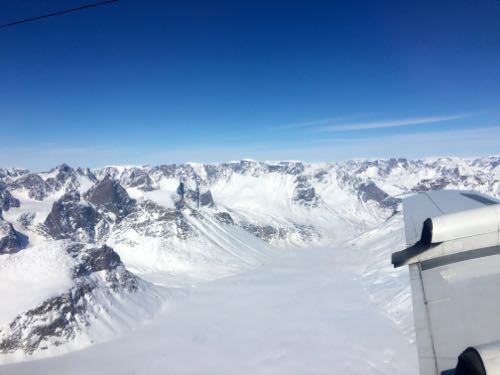The Day
It was another day of weather in Southwest Greenland so again we flew over Canada. Today we went to Penny GlacierA mass of ice that persists for many years and notably deforms and flows under the influence of gravity.. This glacier is a remanent of the last ice age. The Penny Icecap is a smaller ice cap that sits alone. The fact that it sits alone and is small is one of the reasons it is studied, because of these factors it responds to climate change faster. The Arctic is changing every year but how it changes can't be assessed until after the data is analyzed.

It was such a bad day that the plane had to be deiced. A truck comes over to the plane while the plane is parked on the ramp and sprays it down with a pink liquid called propolene glycol. Having ice on a plane is a safety hazard. Ice on the wings can dissrupt the way air moves over the wing which can hinder the planes ability to fly. The hull of the plane also had to be deiced. The weight of the snow could affect the total weight of the planes again making it difficult to fly.
I'm including a link to a movie I made that shows the plane being deiced.
GreenTrACS
Today we had two more visitors on the plane. One was Martin from the Airport's weather office and the other was Gabe Lewis. He is a part of GreenTrACS. Part of their mission is "Thus, in order to improve our projections of Greenland's contribution to sea level rise in the future, we need to improve these models through validation and calibration with real data from the ice sheet, especially along the steep edges." from GreenTrACS website www.GreenTrACS.blogspot.com). Using PolarTREC data, last year Gabe wrote a paper about accumulation in Greenland. After doing the research he realized there was a gap in the amount of data between coastal weather stations. The GreenTrACS group is going to traverse the area using snow mobiles and sleds to carry their equipment to collect the data. The team will take different measurements including ice cores, radar data, and they will also measure albedo. Albedo is the amount of radiation that reflects off the Earth's surface and is reflected back into space.
The traverse will take eight weeks and the team consists of 5 people Karina Graeter and Gabe Lewis, Tate Meehan and HP Marshall from Boise State, and Forrest McCarthy (an all star mountaineer and safety rescue guru). The GreenTrACS team will not see civilization for the entire traverse. They will have air drops of gas and food. They had to bring almost all of their supplies with them. They will be staying in tents and setting up and breaking down their own camp site. It will be cold and they will be exposed to the environment and will have to deal with any weather conditions that may arrise.
For me it was interesting to meet scientists who are using the data collected by IceBridge in their own studies and they are working on expanding the data that already exists. The GreenTrACS team will also use some IceBridge data when the survey areas overlaps. This will help the GreenTrACS team to insure accuracy. It can also work to reinforce the IceBridge data.
I'm including a link to GreenTrACS' website.


Comments